| TrackMate An iPhone app for calculating racetrack betting odds |
What is this app for?
TrackMate is a calculator to use at the racetrack, for calculating “fair” odds of various racing bet types, using the win odds as the best estimate of probability.
TrackMate calculates fair odds for each possible bet, based on the probability of that event occurring. These fair odds can be compared with the tote odds to find overlays, where the tote is paying more than is fair based on the probabilities. A high overlay can signal a good betting opportunity.
TrackMate can be used for all tote betting, including horses and greyhounds. Odds are calculated for the following bet types: Place, Exacta, Quinella, and Trifecta. This app is not for calculating the cost of various combinations of bets, for example a boxed trifecta. There are plenty of other apps that do that, and it is a useful function.
Note that TrackMate uses odds in the form of dividends for a $1 stake, as in Australia and New Zealand. For example $1.10 would be a heavy favorite, and $75.00 would be an outsider. If you are more comfortable with odds in the form “9/5” then this app may not be ideal for you.

Support
If you find a bug, or have feedback, please email support: trackmate.support@simplexify.net. Or, you can always find me on Twitter: @DCWoods.
This page reproduces the help topics within the app, and may answer any questions you have.
Most importantly, if you like the app, please rate it and leave a review on iTunes.
Screenshots
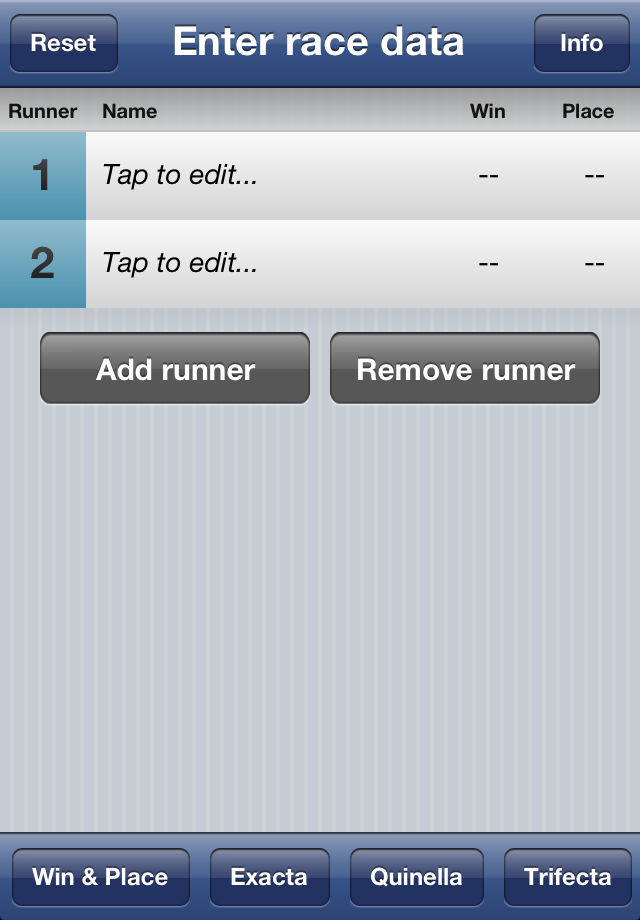 |
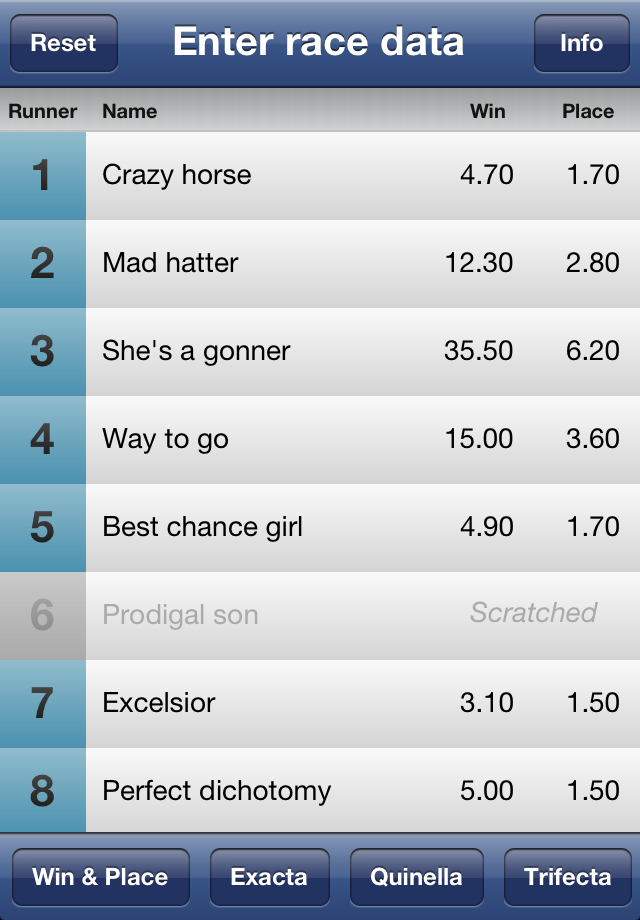 |
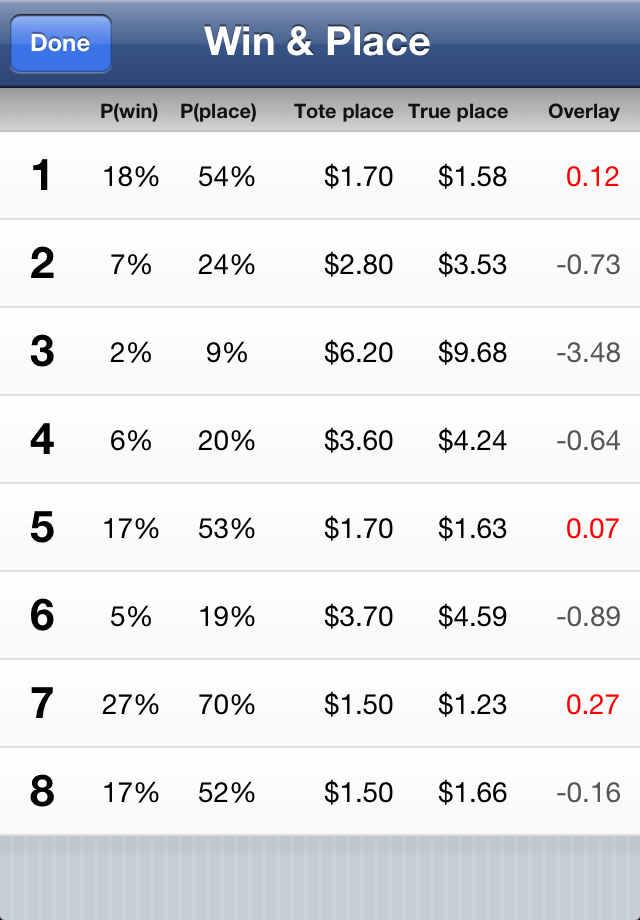 |
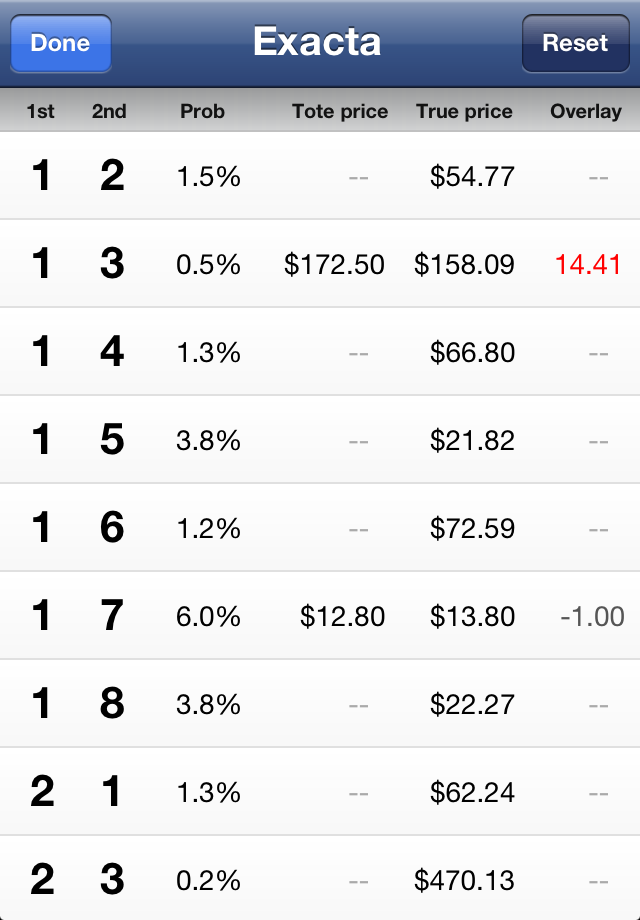 |
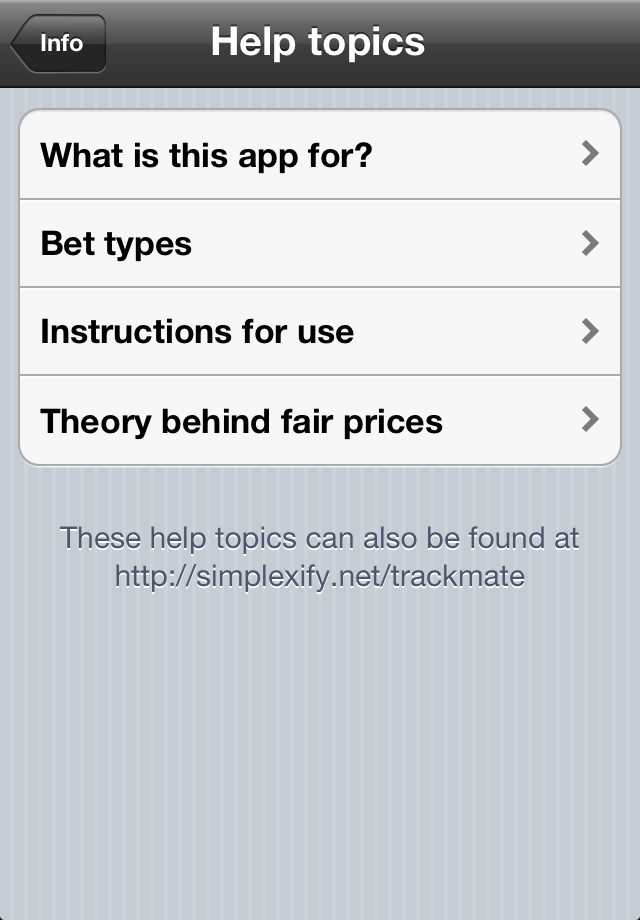 |
Bet types
TrackMate currently calculates odds for the following bet types.
Place
A place bet is made on a single runner and it pays out when the runner comes either first, second, or third.
Place odds can be entered for each runner on the main view, and then overlays viewed in the Win & Place bet view. The probability a horse will place is higher than the probability it will win, so the payouts are lower. Good overlay opportunities are harder to find here than in the more exotic bets, since people can mentally estimate these chances relatively easily.
A good way to use TrackMate for place betting is simply as a filter to eliminate some bad bets (negative overlay) that you might otherwise have made. Another technique is to to use the place overlays to detect good trifecta inclusions, as discussed in the trifecta section below.
Exacta
An exacta bet involves picking two runners, one to come first and one to come second. If you pick the right two runners but the wrong order you don’t win.
The exacta view gives all the combinations of two non-scratched runners, and the associated probability of each combination happening. If there are n runners in the race then there are n * (n - 1) exacta combinations. If they are available, the tote odds for each combination can be entered into the table, and the overlay will be calculated.
There can be a lot of exacta combinations, and people find it hard to calculate these odds in their head so there are often some good overlays available. The best way to use TrackMate is to scan through the list, comparing each entry to the published odds table, and where the tote price is much higher than the calculated price, put this value into the app to compare.
Quinella
A quinella bet involves picking two runners to finish first and second, like the exacta, but to finish in any order.
The quinella view is the same as the exacta view, except that there are half as many combinations. Each quinella combination is listed with the lower-numbered horse first, but they can finish in either order. The probability of a quinella combination occurring is the same as the sum of probabilities of the two matched exacta combinations.
The best way to use TrackMate for quinella bets is the same as for exact - compare the calculated odds with the published odds and note the overlays. Quinella betting is often more popular than exacta betting so the pools can be larger and the odds more stable. Try comparing good quinella overlays with the associated exacta combinations for potentially even better odds.
Trifecta
A trifecta bet involves picking three runners, to come in first, second, and third in the correct order.
The trifecta view gives the probability and “fair” payout for each combination. Because most totes don’t publish their trifecta prices you can’t enter the actual odds to compare. However, it can be very useful to have an idea of the expected payout if your combination does occur.
There are a lot of trifecta combinations: n * (n - 1) * (n - 2). For an 8-runner race there are 336 different possibilities for 1st, 2nd, and 3rd. Each combination has a low probability of occurring, so the payout is often quite large.
Many bettors “box” a certain number of runners, which means that they bet an equal amount on all combinations of the chosen runners, and they win if the runners finish 1st, 2nd and 3rd, in any order. This can get expensive with more runners, e.g. 4 runners boxed is 24 combinations to cover. This approach puts an equal amount of money on each combination, even though some combinations are less likely. An alternative is to bet a proportion of your stake on each combination, based on the expected dividend for that combination.
Because people cannot estimate all the trifecta probabilities effectively, and no guidance is given in the form of published odds, often the combinations that feature favorites are over-bet. This means that other combinations are likely to have overlays, even though we can’t detect this directly. Another effect is that those runners that have negative overlays in the place bets are more heavily bet than they should be, and are likely to also be included in boxed trifectas. If you find good overlays in the place bet view, these can make good trifecta inclusions.
Instructions for use
Overview
- Enter the win odds for all non-scratched runners (as a dividend, e.g. $2.60).
- Choose a bet type to examine.
- Compare published tote prices with the calculated prices to identify overlays. These may be good betting opportunities.
Discussion
Press the reset button on the main screen to remove any previous entries, and then add rows for the number of runners in the race. The only thing you must do is enter the win odds for all the runners in the race, in the form of the dividend paid out for a $1 stake (this is how odds are listed in Australia and New Zealand). Just click on “—” in the win column to edit.
If you want to, you can enter the runners’ names, but this is completely optional. In addition you can enter the place dividends, and then the app will calculate the difference between these prices and the “true” prices. If a runner is scratched, just swipe horizontally across the runner and tap “scratch”.
Entering this data will take around 2-3 minutes (not including names), and then you are ready to calculate the “true” prices. Click on a bet-type at the bottom and you will see the calculated probabilities and dividends for each outcome.
For Place, Exacta, and Quinella bets you can also enter the tote price for any combination, and see the difference between the tote price and the calculated price. This difference is called the overlay, and when it is positive you may have a good bet. For Trifecta bets the tote dividends are not usually published, so you can’t compare.
However, it will probably take too long to enter all the Exacta and Quinella tote dividends into the app, so a good technique is to scan each entry in the dividend table and compare to the value in the app. Those that are significantly over the fair price can be entered and compared in more detail.
A good bet is one where the listed tote price is much higher than the calculated fair price. This means that there is an “overlay” that we can exploit. It doesn’t guarantee a win on any given race, but over time betting this way may give a profitable edge.
Bear in mind that tote prices can change as betting continues, and especially in the last few minutes before the race starts. The probabilities are most accurate with the final post-time prices. It is a good idea to do a final check of the win prices and the prices of any exotic combinations as late as possible before placing bets. When the bet-pool is small, odds are likely to be unstable.
Theory behind fair prices
This is a brief introduction to the theory of racetrack betting markets, as it relates to the functions of this app.
How tote prices are calculated
The way totalisator (tote) betting markets work is that there are a number of bet pools that are completely separate, one for each bet type: win, place, exacta, quinella, trifecta, and some others. As an example, consider the win market.
All the bets that people make on a winner go into a pool of money. The tote operator takes a percentage of this, called the takeout percentage, which is their revenue. The remainder is called the win pool. Note that tote operators get their share regardless of how well individual bettors perform - this is in contrast to regular bookies who set the odds themselves and if a particular bettor does well they lose.
The win prices are then calculated by dividing the win pool by the total amount bet on that horse, so the win pool is divided up among the people who bet correctly, in the proportion of how much they wagered. For example if people bet $1000 on a race and the takeout percentage for win bets is 14.75%, then the win pool will be $855. Say that people had bet $200 on the winning runner, then the win price should be $4.275.
However, this is not the price that is advertised or paid to bettors. There is another concept, called breakage, whereby prices are reduced down to the nearest multiple of 10c. So the “true” win price of $4.275 above is reduced to $4.20. This is similar to rounding, except that the price always goes down, and the tote operator keeps the difference. This means that their actual takeout for any given race will be more than the published rate, and will vary.
The same procedure happens with other bet-types. Each outcome has people betting on it, and the outcome that ends up winning divides the total bet pool among the winners.
Probability of win
The relative amounts bet on each runner to win represent an estimate of the probability of that runner winning. Research has shown that there are some small biases that skew the probabilities, but that on the whole, they are quite accurate.
Unfortunately we usually don’t know exactly how much has been bet on each runner, but we do have the prices. These allow an estimate of the probabilities, with a margin of error due to breakage. If there was no track takeout or breakage then the probability of runner x winning would be rx = 1 / px, where px is the win price of runner x. We can think of this as the raw probability. However, if you added up the raw probabilities of all runners you would get more than 100% - the extra corresponds to the track takeout. To estimate the actual probability px, we divide by the total raw probability:
![]()
where n is the number of non-scratched runners.
Place permutation probabilities
To calculate all the other bet types we calculate the probability of every permutation of runners coming first, second, and third. The other bet probabilities are then found by adding these permutation probabilities up in various ways.
The probability that runners a, b, and c will place in that order is the probability that a wins, times the probability that b wins and a is scratched, times the probability that c wins and both a and b are scratched. If we let X be the set of scratched runners, then:
![]()
The assumption here is that the finishing order is set, and that runners would perform the same if the runners before them were eliminated. This assumption is clearly not always true, but as an approximation it is useful.
Calculating bet type probabilities
Given the permutation probabilities defined above, we can calculate the probability of each outcome for the other bet types. With n runners there are n * (n - 1) * (n - 2) permutations.
- Place - A place bet is won if the chosen runner comes either first, second or third. There will be 3 * (n - 1) * (n - 2) 3-runner permutations that satisfy the place bet.
- Exacta - An exacta bet is won if the two chosen runners come first and second in the specified order. There will be (n - 2) 3-runner permutations that satisfy the exacta: the specified runners in first and second place, and all the remaining runners in third.
- Quinella - A quinella bet is won if the two chosen runners come first and second in either order. Each quinella probability is the sum of the two corresponding exacta probabilities, so there will be 2 * (n - 2) 3-runner permutations that satisfy the quinella.
- Trifecta - A trifecta bet is won if the three chosen runners come first, second and third, in the specified order. Only one of the 3-runner permutations satisfies the trifecta.
Converting probabilities to “fair” prices
To calculate “fair” prices that correspond with the outcome probabilities we have calculated, the track takeout percentages must be considered. If T is the takeout percentage for a given bet pool, and the probability of an outcome x is P(x), then the calculated “fair” price will be:
![]()
Limitations
This approach gives us estimates of “fair” prices, based on approximating the probability of each event. This approach should give more accurate probabilities than those from the associated tote prices, and overlays can be identified. However, this method is only an approximation, and there are several limitations that should be considered:
- The probabilities estimated will be most accurate when based on the final prices. However, these can change rapidly in the last few minutes, so may not be the same as those on which betting decisions are made. To mitigate this, the app should be used as close to the race start as possible.
- Prices can be unstable when betting volumes are low, so prices can change rapidly. This can also be an opportunity to identify overlays. However, in low betting volumes any bet you place can affect the odds, so this needs to be considered.
- An overlay is not a guarantee, or even likelihood, of winning. It indicates that the dividend is more than it should be given “fair” odds, so in the long run betting on overlays should result in a better return than betting randomly.
- Even an overlay is not a guarantee of profitable betting in the long run. In order to have a profitable betting strategy, the overlay should be more than the track takeout.